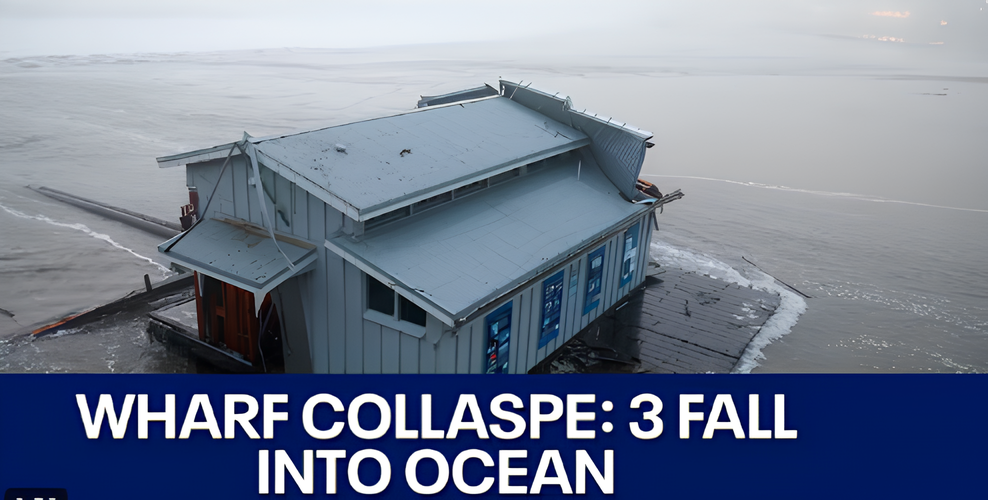The Santa Cruz Wharf, a historic landmark and popular tourist destination, recently experienced a significant collapse. This event has sent shockwaves through the local community and beyond.
In this article, we delve into the details of the Santa Cruz Wharf collapse. We aim to provide a comprehensive overview of the incident, exploring potential causes and the implications for the local community and infrastructure.
We will incorporate eyewitness accounts, expert opinions, and official statements. The response from local authorities and any future preventative measures will also be discussed.
Our focus will be on the Santa Cruz Wharf, but the information may be relevant to other coastal communities. Structural safety and the impact of environmental factors on infrastructure are universal concerns.
Join us as we investigate this unfortunate event. Together, we can learn from it and work towards preventing similar incidents in the future.
Stay tuned for a deep dive into the Santa Cruz Wharf collapse.
The Day of the Collapse: What Happened?
On a seemingly ordinary day, disaster struck the Santa Cruz Wharf. In the early afternoon, a section of the wharf unexpectedly gave way.
The collapse occurred at the midsection, an area heavily frequented by both locals and tourists. This sudden failure took everyone by surprise, disrupting the daily activities on the wharf.
Thankfully, no fatalities were reported. However, several people sustained minor injuries during the chaos. Emergency services quickly arrived on the scene to provide assistance and ensure everyone’s safety.
Local authorities swiftly closed off the area to prevent further incidents. The collapse raised immediate questions about the safety and stability of the entire structure. The community was left to grapple with the reality of losing a part of their cherished wharf.
Immediate Response and Emergency Actions
As soon as the collapse was reported, emergency services sprang into action. Firefighters, paramedics, and the police rushed to the site.
Their first priority was ensuring that everyone was out of harm’s way. They quickly evacuated the area to prevent further injuries.
Rescue teams assessed the damage and searched for anyone who might be trapped. Fortunately, no one was missing or critically injured in the incident.
Local government officials arrived to inspect the situation and coordinate the response. Their presence reassured the community that necessary steps were being taken to address the crisis.
Eyewitness Accounts and Personal Stories
Many locals witnessed the Santa Cruz Wharf collapse unfold. Their firsthand accounts provide compelling narratives of the event.
One visitor described the loud cracking noises that preceded the collapse. It was a sound they said they would never forget.
Others spoke of the panic and chaos that briefly ensued as people hurried to safety. The situation felt surreal and disorienting for those present.
Despite the initial shock, onlookers expressed gratitude for the swift emergency response. They commended the authorities for their quick action, helping to prevent any potential tragedies.
Historical Significance and Structure of the Wharf
The Santa Cruz Wharf holds a special place in the city’s history. Dating back over a century, its presence has been a constant.
Originally built in 1914, the wharf has endured the test of time. It has been a reliable feature of the local landscape.
Its structure exemplifies early 20th-century engineering prowess. Wooden pilings and reinforced concrete have provided enduring stability.
Beyond its physical form, the wharf has cultural significance. It embodies Santa Cruz’s identity, drawing visitors and residents alike to its scenic and recreational offerings.
Investigating the Potential Causes
The recent collapse of the Santa Cruz Wharf has sparked a thorough investigation. The aim is to identify and analyze potential causes. Various factors are under scrutiny.
The physical state of the wharf is a major focus. Engineers are examining structural integrity and historical maintenance practices.
Environmental elements are also being considered. Weather conditions and the impact of the local marine environment could have contributed to its structural weakness.
Materials used in the original construction are being reviewed. Over time, even the best materials can degrade, affecting load capacity.
Attention is also on human errors, such as skipped inspections. Records of past assessments are vital to understanding any overlooked issues.
The investigation remains open-ended, with all possibilities on the table. Experts and local authorities are working together to ensure a comprehensive analysis.
Weather Conditions and Environmental Factors
Weather plays a critical role in coastal infrastructure stability. On the day of the collapse, conditions may have exacerbated existing weaknesses.
Strong winds and tidal movements can weaken structures over time. The ocean’s relentless force wears away at the foundations of even the strongest builds.
Moreover, saltwater corrosion is a known threat to metal and wood. This environmental factor is essential to consider in assessing the wharf’s condition.
Structural Integrity and Maintenance Records
The integrity of the Santa Cruz Wharf is under intense scrutiny. An essential aspect is understanding its current condition and past upkeep.
Regular maintenance and inspections are crucial for structural longevity. Any lapses in these can result in gradual deterioration over the years.
Documented records of maintenance provide insight into potential oversight. The absence of recent inspections could have been a significant factor.
Expert Opinions on the Collapse
Structural engineers offer varied insights into the collapse. Their expertise is pivotal in determining likely causes and prevention strategies.
Some experts suggest the age of the structure played a part. They argue that ongoing wear would inevitably lead to some form of failure.
Others focus on potential design flaws or material fatigue. They highlight that assessing older structures for modern risks is essential.
Impact on the Community and Local Economy
The Santa Cruz Wharf collapse has had a profound impact on the local community. For residents and visitors, the wharf is more than just a structure; it is a symbol of the city’s rich history and vibrant culture.
Local businesses that rely on the wharf are experiencing significant disruption. These establishments are crucial for both the local economy and tourism industry. Their closure affects not only the owners but also employees and suppliers.
Tourism, a major economic driver for Santa Cruz, is facing challenges. The wharf attracted tourists from various places, boosting local revenue. The collapse could dampen visitor numbers and diminish the city’s appeal.
Community members express concern and sadness over the event. Efforts are underway to support affected businesses and reignite the area’s vitality. Restoring the wharf is a community priority, reflecting shared resilience and hope.
Local Businesses and Tourism
Local businesses on the wharf have suffered significant setbacks. With sections closed, many have lost customers and income. The wharf’s closure directly impacts their daily operations.
Tourism sees a decline as well. Many visitors view the wharf as a must-see destination. Its closure forces tourists to seek alternatives, affecting local revenue streams.
Community leaders emphasize the importance of speedy reconstruction. The goal is to reopen businesses and reassure visitors. This will help revive the local economy and restore the town’s allure.
Environmental and Ecological Considerations
The collapse has stirred ecological concerns within the community. The impact on marine life and local ecosystems is a major focus.
Debris from the collapse may harm sea habitats. Environmental groups are closely monitoring the situation, advocating for careful cleanup efforts.
Additionally, restoration plans must consider the preservation of natural habitats. Balancing redevelopment with ecological integrity is crucial. This approach ensures that the rebuilt wharf supports both community needs and environmental sustainability.
Looking Ahead: Cleanup, Reconstruction, and Prevention
Efforts to address the aftermath of the Santa Cruz Wharf collapse are already underway. Cleanup operations have commenced to ensure safety and minimize environmental impact.
Municipal authorities are actively planning the reconstruction of the wharf. This involves assessing structural needs and engaging with experts to enhance design and durability.
Public safety remains a priority in the reconstruction process. Authorities aim to incorporate lessons learned and prevent future incidents. This involves innovative designs and resilient construction methods.
Community involvement is encouraged throughout the process. Public meetings and feedback sessions help gather input, ensuring the wharf meets residents’ needs and expectations.
Timeline and Funding for Repairs
Establishing a timeline for repairs is crucial for recovery efforts. Authorities predict a phased approach to reopening sections of the wharf.
Securing adequate funding is a significant focus. State and federal resources, alongside local funding, will be essential for comprehensive reconstruction.
Transparent communication about progress and funding use is vital. Keeping the community informed fosters trust and optimism during this period of transition.
Future Safety Measures and Design Innovations
Future designs will incorporate advanced safety measures. Engineers are exploring innovative materials and construction techniques to enhance durability.
Weather-resistant materials are a priority. These advancements aim to withstand harsh coastal conditions, reducing long-term maintenance needs.
Additionally, real-time monitoring technology could be implemented. This approach would offer continuous assessments of structural health, preventing future issues and ensuring public safety.
Conclusion: The Road to Recovery for Santa Cruz Wharf
The path to recovery for the Santa Cruz Wharf marks a new chapter. It highlights the community’s resilience and collective strength in overcoming challenges.
Local collaboration and innovative approaches will play a crucial role. Together, they will ensure a safer, stronger future for this beloved landmark.



